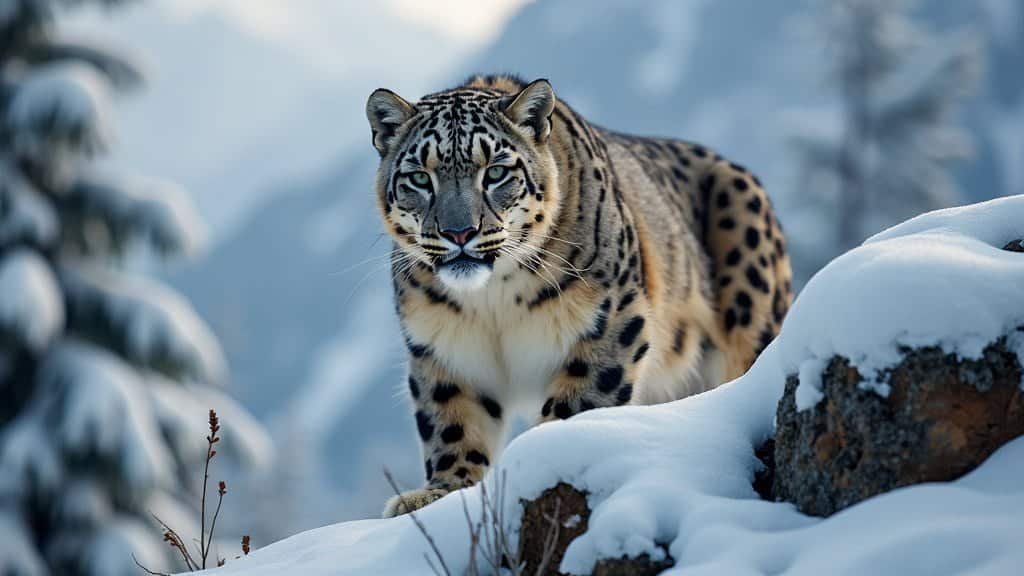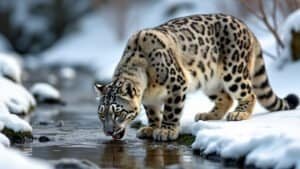Introduction
Snow leopards are elusive big cats that have adapted to some of the most challenging terrains on Earth. These majestic animals are typically found in high-altitude regions, favoring environments that offer both seclusion and strategic advantages for hunting
In this article, we will explore the specific altitude ranges where snow leopards thrive, their remarkable adaptations to rocky and rugged terrains, the types of vegetation found in their habitats, and how snow cover influences their behavior and movement. Each section will delve into the unique aspects of the snow leopard’s habitat preferences, shedding light on the fascinating world of this rare and endangered species
Preferred Altitude Range for Snow Leopards
Snow leopards are highly adapted to life in some of the most extreme environments on Earth. Found primarily in the mountain ranges of Central and South Asia, these big cats inhabit regions that are both remote and harsh, providing them with the seclusion they need to thrive
Altitude plays a significant role in defining their habitat, as snow leopards are typically found at elevations where few other predators can survive
Typical Altitudes
Snow leopards are most commonly found at altitudes ranging from 9,800 to 14,800 feet, though they have been observed at elevations as high as 18,000 feet in the Himalayas
This preference for high altitudes is largely driven by their need for isolation from human populations and other predators. In the summer, snow leopards tend to move to even higher elevations, following their prey into the cooler, more remote areas above the tree line
During the winter, they may descend to lower altitudes, but generally, they remain within the rugged, mountainous terrain that offers them both shelter and opportunities for hunting
The high-altitude regions where snow leopards are found are often characterized by steep, rocky slopes and sparse vegetation. These areas provide the perfect conditions for snow leopards to ambush their prey, which includes species like the blue sheep (bharal), Himalayan tahr, and ibex
The terrain is also a key factor in their solitary lifestyle, as the difficult landscape makes it easier for them to avoid encounters with humans and other large carnivores
Impact of Altitude on Behavior
The altitude at which snow leopards live not only influences their physical adaptations but also their behavior. At these high elevations, the air is thin, and temperatures can drop drastically, especially during the winter months
To cope with these conditions, snow leopards have developed a number of behavioral strategies. For instance, they are known to be crepuscular, meaning they are most active during the early morning and late evening when temperatures are cooler. This behavior helps them conserve energy and avoid the harsh midday sun
Moreover, snow leopards are expert climbers, a skill that is essential for navigating their steep, mountainous terrain. Their powerful hind legs allow them to leap as far as 50 feet in a single bound, which is crucial for chasing down prey in the rocky, uneven landscape
Additionally, snow leopards have a thick coat of fur and a long, bushy tail that helps them maintain balance while moving across treacherous terrain
Adaptations to High-Altitude Environments
The extreme altitudes at which snow leopards live require them to have unique physiological adaptations. One of the most notable adaptations is their large nasal cavities, which allow them to take in more oxygen from the thin air
This is particularly important when they are exerting themselves while hunting or moving across the rugged landscape. Additionally, snow leopards have a dense, insulating coat that protects them from the cold, and their large, fur-covered paws act like natural snowshoes, distributing their weight more evenly and preventing them from sinking into the snow
Their ability to thrive at high altitudes also has an impact on their prey. Many of the animals that snow leopards hunt are also adapted to life at these elevations, which means that the snow leopards must be able to track and hunt them in these challenging environments
This interdependence between predator and prey creates a delicate balance in the high-altitude ecosystems where snow leopards live
Adaptations to Rocky and Rugged Terrains
Snow leopards are masters of survival in some of the world’s most challenging landscapes. The rocky and rugged terrains they inhabit present numerous obstacles, but these big cats are perfectly adapted to navigate, hunt, and live in these environments
Their physical and behavioral adaptations have evolved specifically to give them an edge in the harsh conditions of their mountainous homes
Physical Adaptations
One of the most remarkable physical adaptations of the snow leopard is its powerful and agile body, which is ideally suited for the steep, rocky slopes of its habitat
Snow leopards possess exceptionally strong hind legs that allow them to leap great distances, often covering up to 50 feet in a single bound. This ability is crucial for crossing the deep ravines and large boulders that are common in their mountainous environments
In addition to their powerful legs, snow leopards have a long, thick tail that serves multiple purposes. Not only does it help them maintain balance when navigating precarious cliffs, but it also acts as a warm blanket when they rest. The tail is typically wrapped around the body and over the face to conserve heat during the cold nights
Their paws are another critical adaptation. Snow leopards have large, fur-covered paws that function like natural snowshoes, distributing their weight more evenly across the snow and preventing them from sinking in
The pads of their paws are also covered with fur, providing additional insulation against the cold ground and improving their grip on slippery surfaces
Hunting in Rocky Landscapes
The rocky terrain offers snow leopards a unique advantage when it comes to hunting. Their coat, which is patterned with rosettes and spots, provides excellent camouflage among the rocks and snow
This natural disguise allows them to stalk prey without being easily detected. They are patient hunters, often waiting motionless for extended periods before launching a surprise attack
Snow leopards primarily hunt mountain-dwelling animals such as ibex, blue sheep, and Himalayan tahr, which are also adapted to rocky terrains. These prey animals are agile and fast, but the snow leopard’s strength and ability to navigate steep slopes give it a crucial advantage
When hunting, snow leopards rely on their stealth and the element of surprise, often attacking from above by leaping down onto their prey from higher ground. This hunting strategy is particularly effective in the rugged terrain, where sudden drops and sheer cliffs can make escape difficult for the prey
Navigation Techniques
Navigating the treacherous landscapes where they live requires snow leopards to be both cautious and highly skilled. Their keen sense of sight allows them to spot potential dangers or prey from great distances, while their acute hearing helps them detect the slightest sounds of movement
Snow leopards are known for their ability to move silently, which is essential not only for hunting but also for avoiding predators and other threats
Their bodies are built for balance and agility, allowing them to climb steep rock faces and move across narrow ledges with ease. When traversing these challenging landscapes, snow leopards use their long tails as a counterbalance, helping them maintain stability even on the most precarious surfaces
Their strong, flexible bodies enable them to twist and turn in mid-air, which is particularly useful when making quick, sharp movements during a chase
In addition to their physical prowess, snow leopards also use strategic paths and trails that they have learned over time. These well-worn routes often follow natural features of the landscape, such as ridges, valleys, and cliff edges, which provide both cover and efficient movement through their territory. By following these paths, snow leopards can conserve energy and reduce the risk of accidents in the dangerous terrain
Vegetation in Snow Leopard Habitats
While snow leopards are primarily carnivorous and not dependent on vegetation for their diet, the plant life in their habitats plays a crucial role in the overall ecosystem
Vegetation affects prey availability, provides cover for both predators and prey, and contributes to the biodiversity of the regions where snow leopards live. Understanding the types of vegetation found in these habitats helps to appreciate the delicate balance that supports these elusive big cats
Common Plant Species
The vegetation in snow leopard habitats varies significantly depending on altitude, climate, and geography
Generally, snow leopards are found in high-altitude regions that feature alpine and subalpine vegetation. At elevations between 9,800 and 14,800 feet, where snow leopards are commonly found, the vegetation is often sparse due to the harsh climatic conditions
Common plant species in these areas include grasses, shrubs, and hardy perennial plants that can withstand the cold and wind. For instance, junipers, rhododendrons, and various types of grasses are prevalent in these regions. These plants are well-adapted to survive in poor soil conditions, with many having deep root systems to anchor them in the rocky terrain
In lower altitudes, closer to the tree line, small coniferous trees and shrubs become more common
These plants provide essential cover for prey species like the blue sheep and ibex, which in turn, support the snow leopard population. The availability of this vegetation is crucial, as it influences the distribution and density of prey species in these mountainous regions
Seasonal Vegetation Changes
The vegetation in snow leopard habitats undergoes significant changes with the seasons, which in turn affects the behavior and movement of both prey and predator
During the short summer months, the alpine meadows come to life, with a burst of growth that provides food for herbivorous animals like the Himalayan tahr and bharal. This increase in prey availability often leads snow leopards to higher elevations, where they can hunt more effectively
As winter approaches, the vegetation becomes sparse, and many herbivores migrate to lower altitudes in search of food. Snow leopards often follow these movements, descending to lower elevations where prey is more abundant. The reduction in vegetation during the winter also means that snow leopards must rely more on their stealth and camouflage to hunt, as the lack of cover can make stalking prey more challenging
The seasonal changes in vegetation also impact the snow leopard’s denning behavior. During the harsh winter months, snow leopards seek out rocky outcrops and caves that are well-insulated and protected from the elements
The availability of these shelters, often surrounded by sparse vegetation, is critical for the survival of snow leopard cubs, which are born during the late winter to early spring
Role of Vegetation in Prey Availability
Vegetation plays a vital role in determining the distribution and abundance of prey species, which are the primary food source for snow leopards
The health and density of herbivorous populations, such as blue sheep, ibex, and Himalayan tahr, are directly influenced by the availability of vegetation. In regions where vegetation is plentiful, prey populations tend to be more stable, providing a reliable food source for snow leopards
Conversely, areas with degraded or sparse vegetation can lead to reduced prey availability, forcing snow leopards to expand their territories in search of food. This expansion can increase the risk of conflict with humans, particularly in areas where livestock grazing overlaps with snow leopard habitats
Conservation efforts aimed at protecting and restoring vegetation in these regions are therefore critical not only for the health of the ecosystem but also for the survival of snow leopards
Snow Cover and Its Impact on Habitat
Snow leopards are uniquely adapted to live in some of the coldest and most snow-covered regions on Earth
The presence of snow, and its varying depth and coverage throughout the year, plays a significant role in shaping the behavior, movement, and survival strategies of these elusive big cats. Understanding how snow cover impacts their habitat is crucial to comprehending their overall ecology
Seasonal Snow Patterns
In the high-altitude regions where snow leopards reside, snow cover varies greatly depending on the season. During the winter months, heavy snowfall is common, especially at higher elevations
This snow can create a blanket several feet deep, covering large areas and significantly altering the landscape. Snow leopards are well-adapted to these conditions, with their thick fur providing insulation and their large paws distributing their weight to prevent sinking into the snow
In contrast, the summer months bring a reduction in snow cover, with many areas experiencing only patches of snow at the highest elevations. This seasonal reduction in snow allows for greater mobility and access to different parts of their territory
The change in snow cover also influences the behavior of their prey, which often move to higher altitudes during the summer to graze on the newly exposed vegetation. Snow leopards follow these movements, adjusting their hunting strategies according to the changing conditions
Influence of Snow Depth on Movement
Snow depth is a critical factor that influences how snow leopards move through their environment. In areas with deep snow, their large, fur-covered paws act like natural snowshoes, helping them move more easily over the surface without sinking. This adaptation is essential for both hunting and traveling across their vast territories, which can cover hundreds of square miles
However, deep snow can also pose challenges. It can make hunting more difficult, as it may slow down both the predator and the prey, leading to fewer successful hunts
Additionally, deep snow can force snow leopards to expend more energy while moving, which is particularly taxing during the winter months when food is scarce. To conserve energy, snow leopards often move along ridges and other areas where snow is less deep, using their knowledge of the terrain to navigate the easiest paths
Snow depth also affects the snow leopard’s choice of den sites. During the winter, they seek out areas with shallow snow cover or sheltered spots, such as caves or rocky crevices, where they can rest and conserve energy. These den sites are crucial for survival, particularly for females with cubs, as they provide protection from the harsh weather and potential predators
Snow Leopard Behavior During Heavy Snowfall
Heavy snowfall can significantly alter the behavior of snow leopards. During periods of intense snow, these big cats may reduce their activity levels, spending more time resting in sheltered areas to conserve energy
This behavior is especially common during blizzards or prolonged snowstorms, when visibility is low and moving through the snow becomes increasingly difficult
Despite the challenges posed by heavy snowfall, snow leopards have developed strategies to cope with these conditions. For example, they are known to hunt in areas where the snow has been partially compacted by wind or where prey animals have already cleared paths. This allows them to move more efficiently and increase their chances of a successful hunt
In regions where snowfall is particularly heavy, snow leopards may also adjust their hunting techniques. They often rely on ambush strategies, taking advantage of the snow-covered landscape to blend in and surprise their prey
The snow provides excellent camouflage, as the snow leopard’s pale, spotted coat helps them remain nearly invisible against the snowy background. This advantage is particularly useful when stalking prey in open areas where cover is limited
Heavy snowfall also impacts the prey species that snow leopards rely on. Herbivores like blue sheep and ibex may struggle to find food during the winter, leading them to move to lower elevations where vegetation is more accessible
Snow leopards often follow these prey movements, adjusting their territory and hunting grounds according to the availability of food. This seasonal migration is a critical aspect of their survival strategy in the harsh winter environment
Conclusion
Snow leopards are extraordinary creatures, perfectly adapted to some of the harshest and most challenging environments on Earth. Their preference for high-altitude, rugged, and snow-covered terrains has led them to develop unique physical and behavioral traits that ensure their survival in these remote areas
From thriving at altitudes between 9,800 and 14,800 feet, to navigating rocky landscapes with their powerful hind legs and large, fur-covered paws, snow leopards demonstrate remarkable resilience. The vegetation in their habitats plays a crucial role in supporting prey species, while seasonal snow cover significantly influences their movement and hunting strategies
Understanding these aspects of snow leopard habitats is essential for their conservation, as it highlights the delicate balance they maintain within their ecosystems and the challenges they face in an ever-changing environment












